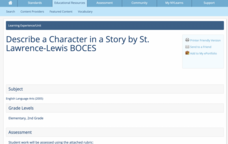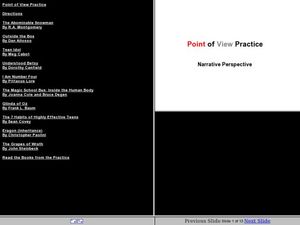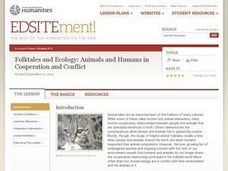Curated OER
Build Mastery: Main Idea
Use a graphic organizer to get readers thinking about main ideas as they record the who, what, where, when, and why of a story. Consider modeling this process completely before kids do this independently. They fill in five boxes charting...
Curated OER
Comparing Works By The Same Author: Venn Diagram
A Venn diagram is a great tool. Middle schoolers research specific authors from different time periods, cultures, and genres. In groups, they create a Venn Diagram in order to compare and contrast two pieces of literature by the same...
Curated OER
"Knot" the Whole Truth: Writing a Modern-Day Story with a Tall Tale's Voice
Beyond Paul Bunyan and his blue ox, tall tales can be a great way to teach young writers about word choice and voice in their writing. Using Jerry Spinelli's Maniac Magee and the Six-Trait Writing process, they begin to write their own...
Curated OER
Harry Potter and the Spellbound Children
Help your class explore the world of Harry Potter. Learners visit selected websites to learn the background about the book series, discover details about the marketing of the books, and investigate book banning.
Curated OER
Build Mastery: Fact and Opinion
Is it a fact or an opinion? Get your kids up and moving during this reading comprehension activity. They listen to you read a book or passage (consider writing something yourself to get the ideal text), listening for facts and opinions....
Curated OER
Bronze Bow
Explore ancient Rome through reading The Bronze Bow by Elizabeth George Speare. Readers activate prior knowledge by examining objects that relate to the story and predict the significance of the items. Their curiosity is aroused through...
Curated OER
Novel Ideas: History of the American Novel
Explore the history of the American novel in the contexts of literature and US history. How does a novel or piece of writing from a particular time showcase the mood during that historical period? After conducting research and discussing...
Curated OER
"Weighing the Elephant"
Can your class solve the problem presented in the Chinese folktale, "Weighing the Elephant?" Read your class the description before having them attempt to solve the problem. After they've come up with an answer (or attempted to!), finish...
Curated OER
Main Idea/Supporting Details Scavenger Hunt
Engage your class in a scavenger hunt to find the main ideas and supporting details in a text. They follow the teacher while s/he models how to determine main idea and find supporting details, and then they work independently. A fun way...
Curated OER
Reading Connected Text Fluency (Passage)
Practice makes perfect when it comes to reading fluency! Walk your emerging readers through a familiar passage, slowly pointing to each word to keep every learner with you. While looking at a projected passage, scholars read one word at...
Curated OER
Literature Review Paragraph
Tenth graders review the structural elements of a literary paragraph and organizational paragraph formats. They author a paragraph examining and reviewing a piece of literature currently being read in class. Students peer-review the...
Curated OER
Recognizing Cause and Effect
Students define cause and effect and recognize an effect as something that happens as a result of a cause. They apply information they have learned about cause and effect to their study of literature.
Curated OER
Describe a Character in a Story
Second graders should be familiar with characters of a story and adjectives. The students should have some knowledge of Kidspiration. After reading a story, they will use Kidspiration and create a character web to describe a character in...
Curated OER
Twain's Hannibal
Young scholars use primary resources to examine the context the writings of Mark Twain. They criticize the resources for reliability, accuracy, perspective, relevancy, and authoritativeness.
Curated OER
Reader Response
Fifth graders reflect upon different concepts of Language Arts while reading literature. In the novel Tuck Everlasting, by Natalie Babbitt, the characters discover a spring of eternal youth. After reading the first several chapters of...
Curated OER
Founders of the Children's Rain Forest (Open Court)
Fifth graders read a narrative nonfiction piece describing the formation of the Students's Rain Forest organization from the SRA/McGraw-Hill Open Court Reading Anthology entitled, Cooperation and Competition. Founders of the Students's...
Curated OER
Bearstone: A Novel Analysis
Seventh graders need to be able to distinguish between major and minor characters and need to have read the novel Bearstone and be familiar with the sequence of events as well as the qualities displayed by each character over the course...
Curated OER
English Literature Circles
Students examine how to develop self-expression, inter-personal skills, and an Student have an appreciation of literature. This is accomplished through small groups, ideally located in a library setting where the teacher and the...
Curated OER
Point of View Practice: Narrative Perspective
Excerpts from ten texts (There's something for everyone from Steinbeck's Grapes of Wrath to Covey's Seven Habits of Highly Effective Teens, and more!) provide the springboard for an examination of point of view. For each short excerpt,...
Curated OER
Inventions and Magic
Explore physical science by reading Barthlomew and the Oobleck by Dr. Seuss. Discuss the moral of the story and the discretion an inventor must use when creating something they want instead of something they need. This lesson is embedded...
Curated OER
Folktales and Ecology: Animals and Humans in Cooperation and Conflict
Story elements such as conflict, character analysis, resolution, and moral are discussed and charted as elementary children read folktales involving animals. An element of science is also introduced as learners discover what a keystone...
Curated OER
Introduction to Drama
Introduce your class to drama! You cast each pupil as a different character from a story you have read. They are given a general outline of the scene, act out the scene multiple times, then discuss the weak and strong aspects of each...
Curated OER
Drama-Dialogue
Use drama to study and practice dialogue. Creative minds discuss what dialogue tells about a character, and how it can be used to advance the plot. They read a play, think about what they gleaned from dialogue, and record their...
Curated OER
Plot the Oysters' Peril!
Use comic strips to teach sequencing in narrative poetry. As homework, each class member selects a comic strip with 4-8 frames, cuts the frames apart, places the pieces in an envelope, and brings the envelope to class. Class members swap...

























